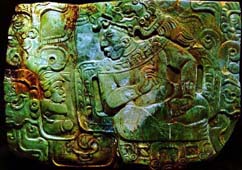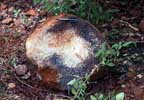Jade

Jade Nebaj, Quiché. Classic Period
For most people, the word “jade” evokes exotic images of richly
laden Chinese emperors. Few people realize the rich jade history of
the Americas. To the Pre-Columbian people of Mesoamerica, specially
the Maya, jade meant
life, fertility, and power; it was revered above gold. The
association of the aristocracy with the brighter greens indicated
that they valued jade above all other materials. Just as bright
green jade was reserved for Chinese emperors, in Mesoamerica, bright
green jadeite was reserved for kings and royalty. As an example of
its desirability, the Spanish conquistador Hernán Cortéz was given
four jade beads as tribute by Aztec leader Moctezuma, with the
counsel that each bead was worth two loads of gold. The Spanish
conquistadores, lusting only for gold, dismissed these treasures as
nothing more than green rocks. the following objects were made of
jadeite by the ancient Maya: beads (plain and carved), pendants,
pectorals, "sawn into thin flat plates prior to shaping", earflares,
buttons, celts, spangles, inlays, mosaics (e.g., mosaic masks), and
plaques. There are also a variety of more esoteric items, for
example, pieces used for blood-letting in religious
rituals.
Most remarkable is the recent tracing by mineralogist George Harlow
of Preclassic jadeite “axes” found on the Island of Antigua back to
their parent mines in Guatemala. Antigua is nearly 3000 km east of
the Motagua valley as the crow flies, and 3500 km island hopping
Cuba, Hispanola, etc. Rocks don’t float. Only by canoe could they
have made their way across the entire Caribbean. A unique and
valuable trade item tends to become more valuable as it is traded
farther from the source. The incentive is to profit by continuing to
trade it until one of three things happens: an owner can’t bear to
part with it, it reaches a cultural area where it is not valued, or
it reaches the bitter end of the trade route. For the jadeite axes
found on Antigua, the second and third may have both applied.
Antigua was the far eastern edge of the Taino cultural area and of
the Caribbean island chain.
|

Green Jade
|

Preclassic Jade Petén |

Galactic Gold Jade |
Following the Spanish conquest of the native culture and religion,
and in order to hide the jadeite from the conquerors, Indians
withdrew from jade mining and carving for generations. So much time
lapsed and so many generations passed that no one knew where to find
jade; the mines were lost to the world from the 1500s until the late
20th century
|

Jadeite rock |

Jadeite
Rocks |

Jadeite rocks being transported |
|

Grey Jade Tikal |

Jade Incrustations,
Ixlú |

Necklace Tikal |
|

Blue Jadeite |

Mesoamerican Jade Sources
|

Funeral Urn Tikal |
|
 |

Jade masterpieces |
 |
|

Blue Jadeite |

Crystal Green Jade |

Tikal' s Tomb 160 Jade Mask |
|

Choromelanite jadeite from the Motagua Valley. |
 |

Río Azul, Mask |
|

Jadeite recently fractured |

Ancient Jade |

Bluish Jadeite |
|

Tikal, Pectoral |

Jadeite boulder in Motagua Valley |

Tikal Pendant |
Until recently, serious gem and jewelry collectors and buyers looked
to Asia for the purchase of fine jadeite. Traditionally thought of
as a Chinese product, but principally from Myanmar (formerly Burma),
jadeite has been cut and shipped from Hong Kong to the west for
decades. Today, jade enthusiasts are finding jadeite is being mined
and cut closer to home. Fine jadeite material in natural colors
ranging from a bright, intense green to soft lilac, blue, pink,
white, and yellow is available from Guatemala, in Central America.
Although jadeite occurs in several locales around the world,
Guatemala has been the least-known as a producer of this material.
Known sources of jadeite world-wide are
relatively limited. The most important sources are located in Burma,
Guatemala, Japan, and Kazakhstan.
“Jade” is the generic term describing two distinct stones: nephrite
and jadeite. While the two are visually similar, they are different
in mineralogical characteristics. Nephrite and jadeite are both
white in their pure state, with all colors caused by inclusions of
other minerals. Jadeite is the harder and denser of the two, with a
richer, more brilliant range of colors. For these reasons and
because of its scarcity, jadeite is the most precious and
sought-after type of jade. while even the best rough nephrite sells
for only a few dollars a pound, "gem jadeite sells for hundreds to
thousands of dollars a carat". There is no known source of
nephrite in Mesoamerica or Central America.
"Guatemalan jade is jadeite. The Jadeite
is formed by enormous pressures at low temperatures, Guatemala sits
over the subduction zone of the Cocos plate, with the North American
plate grinding along the Caribbean plate at the Motagua fault"
Chalcedony, is a quartzite. A
blue-green variety, sometimes referred to as chrysocolla chalcedony,
is mined in Guerrero, Mexico, and the middle Motagua River Valley,
Guatemala, and also features prominently as a material for
Precolumbian Costa Rican artifacts. This variety of chalcedony is
commonly referred to as "jade" in Mexico and Costa Rica, in
Guatemala it is called "Guatemalita". The color of the
Mexican variety is derived from chrysocolla, a copper phyllosilicate.
The Guatemalan variety also may have inclusions with pyrite, galena,
and calcite.
 
The Motagua Valley
That jadeite in serious quantity and in a rainbow of natural colors
(no heat treatments or other enhancements are used in the Guatemalan
jadeite, opposed to the majority of Myanmar types, that use them to
enhance the color and quality ) is being mined in Guatemala comes as no surprise to
researching geologists and archaeologists who have long believed
that all the native Central American ancient cultures - Olmec,
Toltec, Mixtec, Zapotec, Aztec, and
Maya got their jadeite from
Guatemala. the only confirmed source of jadeite that is similar to
that worked by the Olmec is from the Motagua River Valley, in
Guatemala and within Maya territory, Not Guerrero as some scholars
believe due to Jade workshops found there, but no Jade sources have
been found in Mexico to date, only Green Serpentine of less quality
than Jade.
In Jades of Mesoamerica, author and jade expert Fred Ward has
compiled exhaustive research on Guatemalan jadeite used in the
ancient Maya culture. He writes that discoveries of jadeite in the
Motagua Valley area of Guatemala (also known as the Motagua Fault
Zone) confirm the country as the source for most if not all of the
jadeite used by Mesoamericans for three thousand years. There are
notable workshops for Jade in sites such as
Guaytán on the Motagua
Valley, El Aguilucho
in the Mountains of Sierra de Las Minas and
Cancuén, witch gave this site a wealth not seen in any other Maya
Site. Jade is found in several locales in Guatemala: in the
departments of Izabal, El Progreso, Zacapa, Baja Verapaz, and El
Quiché. It takes an expert's eye to find jade because the boulders
are generally covered with thick, black-brown, or gray rind, making
it almost impossible to distinguish jade from ordinary rock. In
August 2007, a group of archaeologists discovered along the mountain
ridges north of the valley, a series of sites up to the Caribbean
coast that controlled the commerce routes of Jade and Obsidian from
its sources to the Petén Lowlands and the maritime routes
The
elusive “Olmec Blue” jadeite was discovered in the southern part of
the Motagua Valley by Geophysicist Russell Seitz of Cambridge and
with a team of jade researchers including Harlow and Virginia Sisson
of Rice University. The Motagua river parallels the left-lateral,
strike-slip Motagua fault that offsets the rocks of the region by
1,200 kilometers. This displacement led the geologists to believe
that south of the fault lay different basement and surface rocks and
hence, “there was no reason to look there”, but Seitz, was
suspicious and in 1999, while touring this area he saw an
unmistakable “Olmec jade” handcraft, south of the river.

The top two pieces of jadeitite are
recent finds from Río Jalapa drainage, Guatemala, and the bottom is
a fragment of
an Olmec-style jade dish
Seitz and his colleagues announced their discovery of Olmec blue
jade in the December 2001 issue of Antiquity. In late May this year,
a New York Times article described their findings of a “Rhode
Island-Size jade lode.” Exploring the mountain region by foot
and horseback, the group expanded the known jade-bearing zone 10
kilometers north, 18 kilometers east and 18 kilometers south, to
about the size of Rhode Island. The presence of the jadeitite south
of the Motagua fault indicates that while the surface collisional
rocks on either side are different, the basement rock may be the
same. The recent discovery indicates the Motagua fault is more than
just a single fault, and a new geological map of the region is
needed. “Serpentinite is buoyant, like a cork,” Harlow says. He
suggests the additional faults provided fractures and openings that
allowed the serpentinite to carry precipitated jadeitite from the
subduction zone to the surface. The geologists concentrated their
search for the blue-green jadeitite north of the Motagua river where
serpentinite, jadeitite’s host rock, is plentiful.
There are some visual differences in the jadeites of Myanmar and
Guatemala, the most obvious of which is color. Although some
individual pieces of Guatemalan jadeite cannot be separated from
their Burmese counterparts (particularly after they are worked into
jewelry), the majority of materials have distinct color and often
textural differences.

42
Jade Colors from Guatemala
What is abundant in Guatemala is jadeite in natural colors of lilac,
blue, pink, white, yellow, black, and a unique black with natural
precious metal (Gold, Silver and Platinum) inclusions (Galactic
Gold), along with many shades of green. Guatemala is now producing
the world's newest jadeite colors, including “rainbow jadeite”
(several colors in one slab or boulder). Black jadeite from the
Motagua Valley area, represents the creamiest, richest, and best
black jadeite in the world, far exceeding Burma's darkest, which is
gray and can only be sold as charcoal.” Modern Guatemalan lapidaries
make two types of item from jadeite: replicas of ancient pieces and
modern jewelry. The modern items mainly consists of oval cabochons
and beads. The cabochons are set in gold, silver, or gold-plate as
rings, earrings, and pendants
Related links:
http://www.famsi.org/reports/03023/index.htm
(Jadeite sources in Mesoamerica)
http://www.losartesanos.com/guatemala/jade/
http://www.cigem.ca/pdf/jadeite.pdf
|